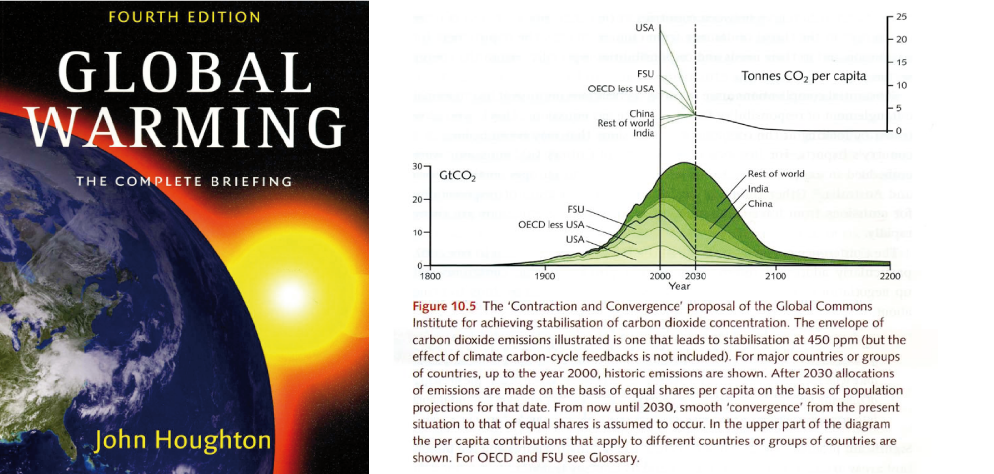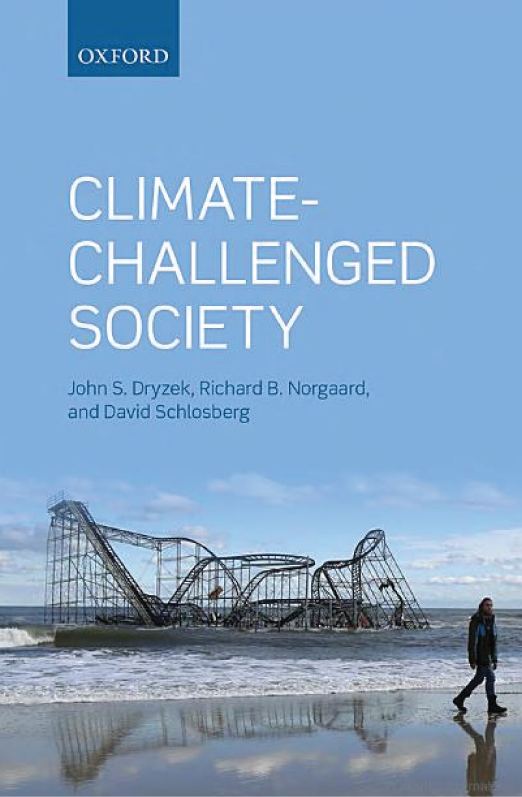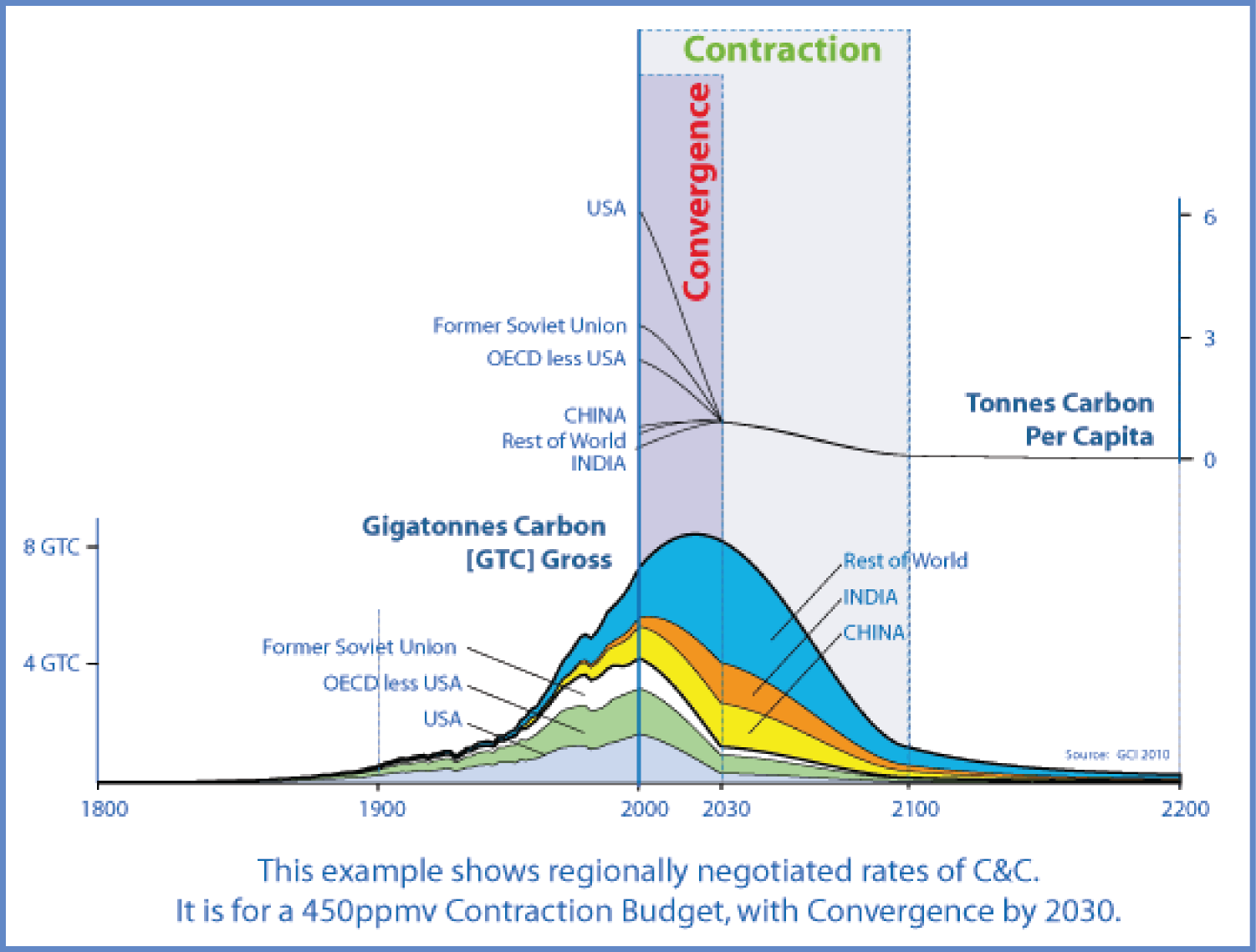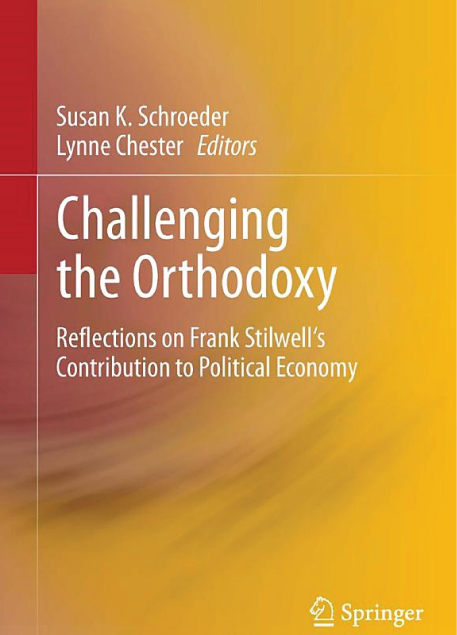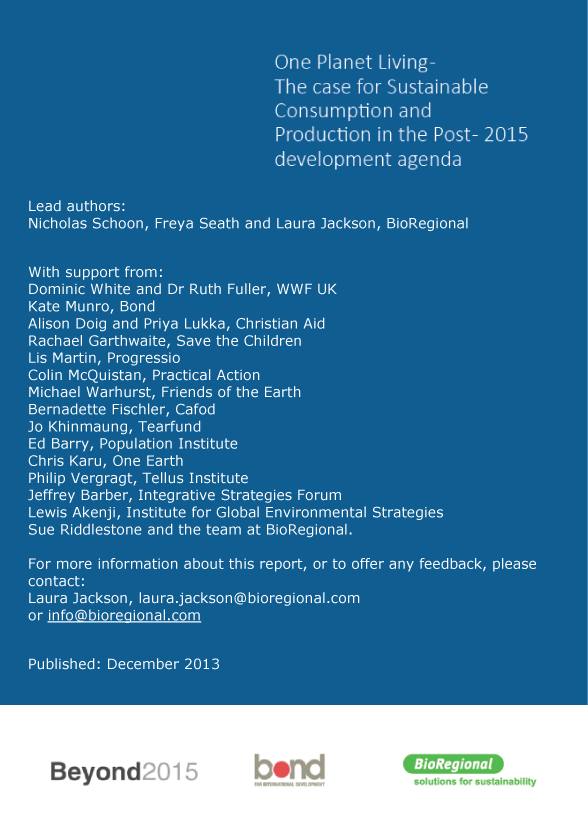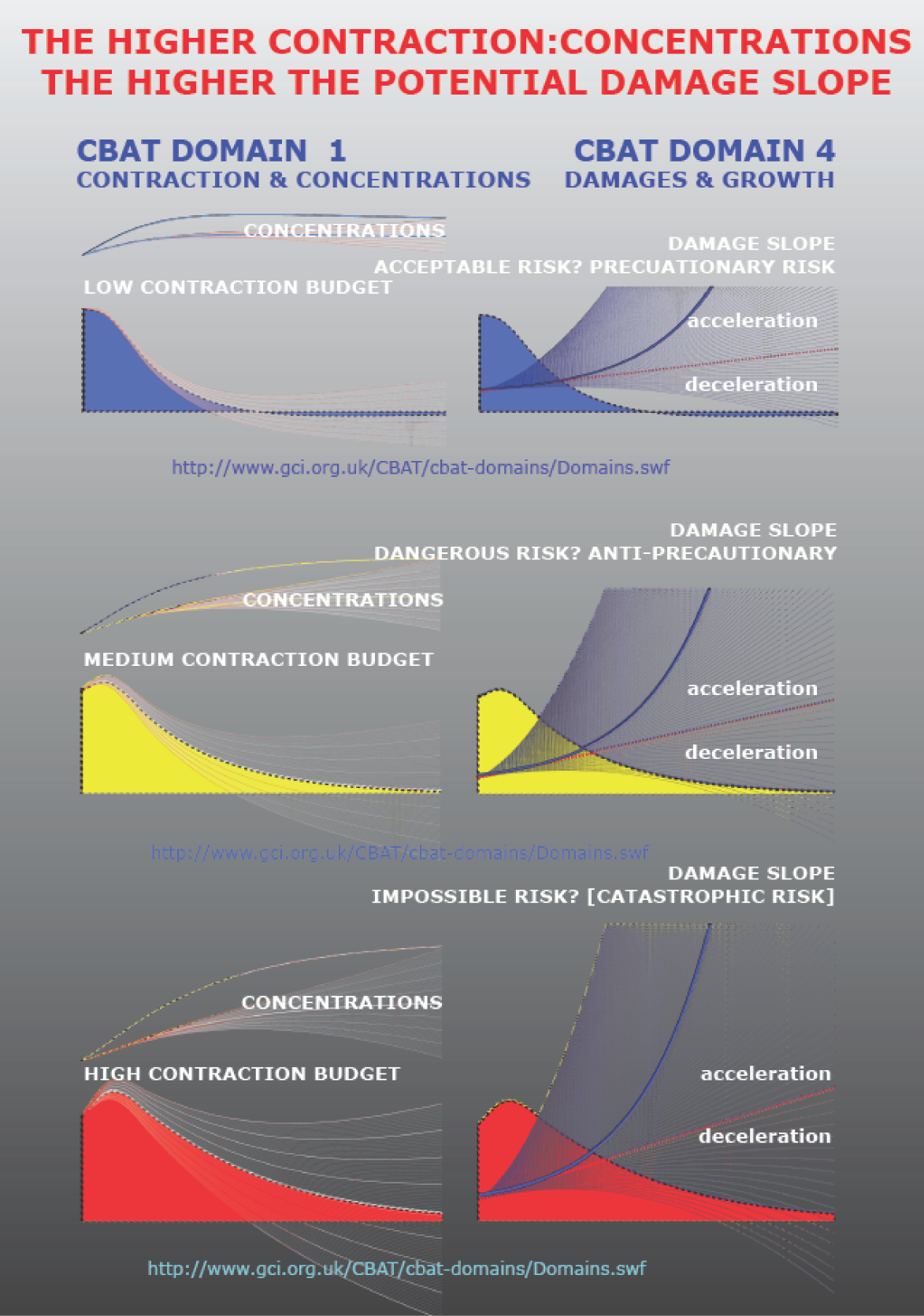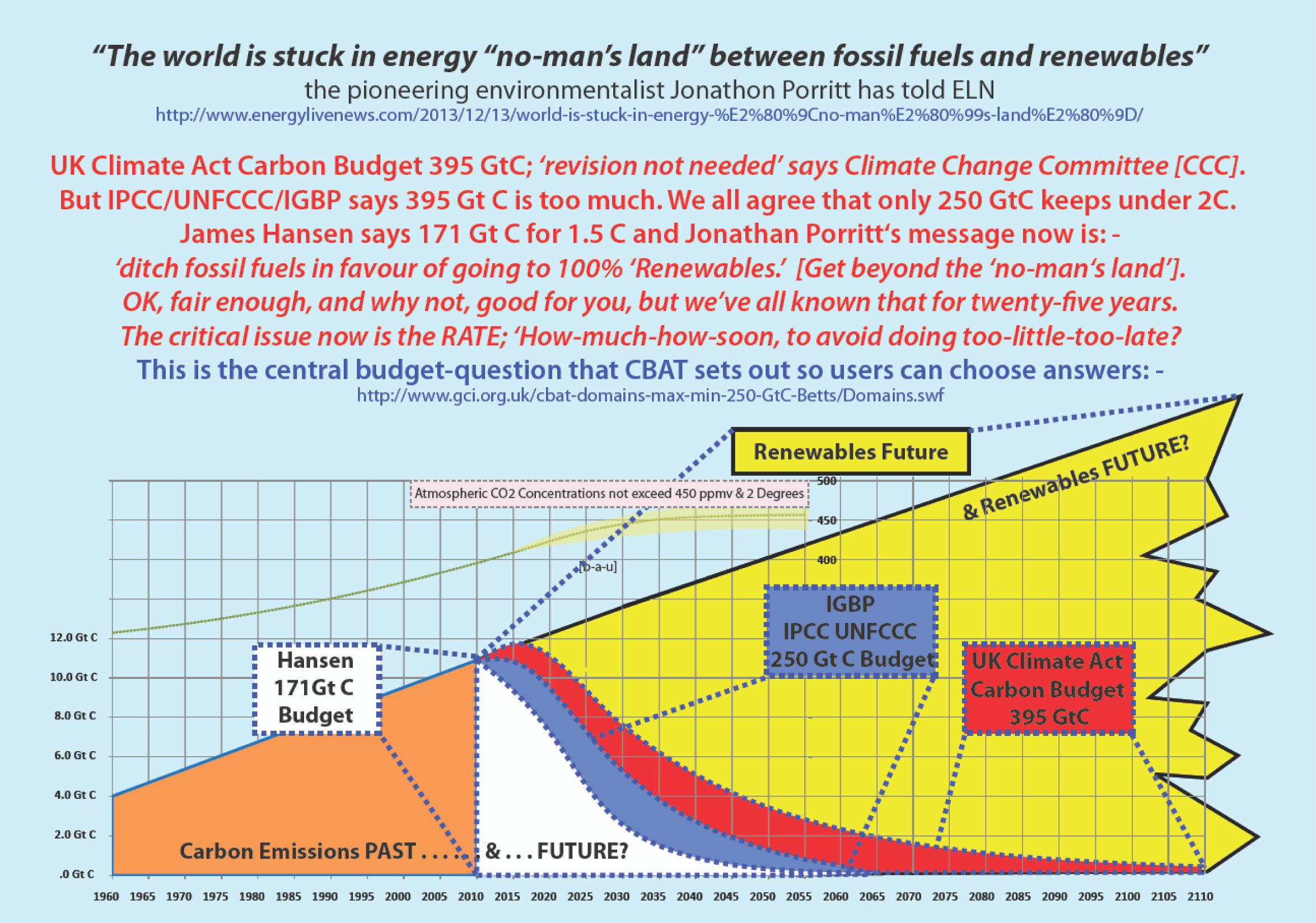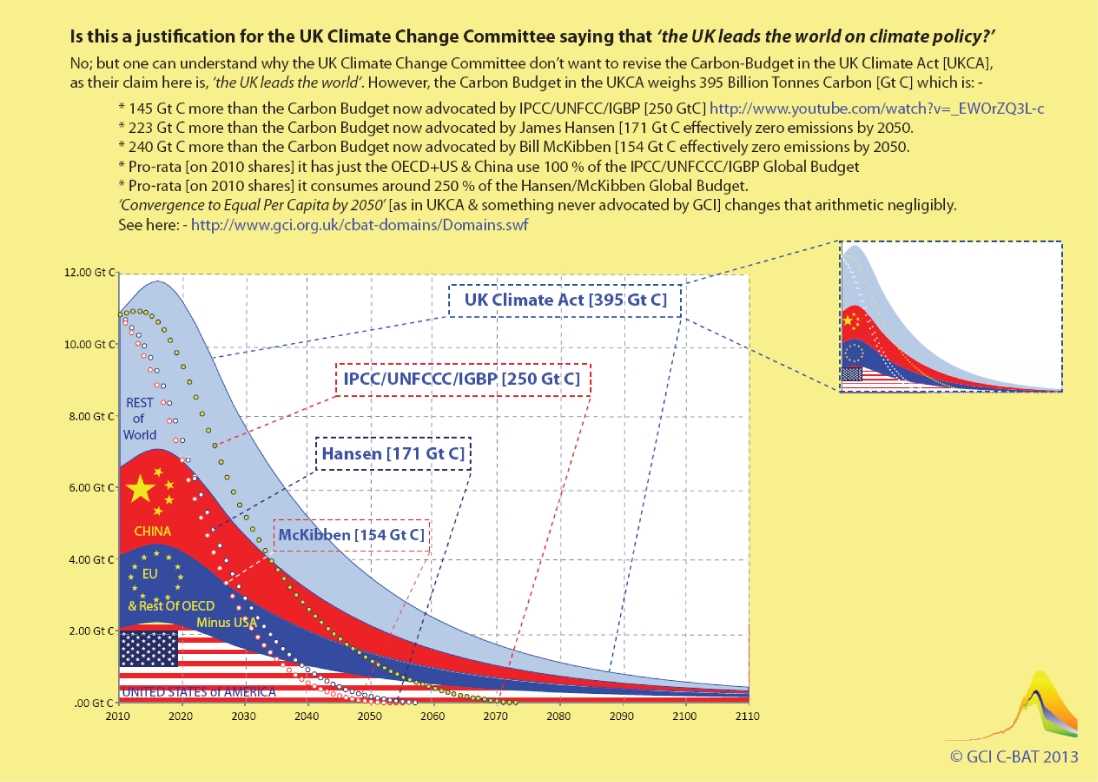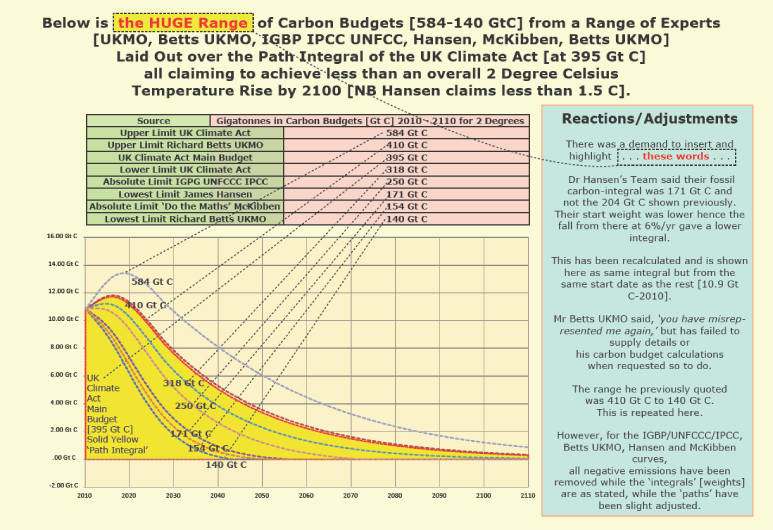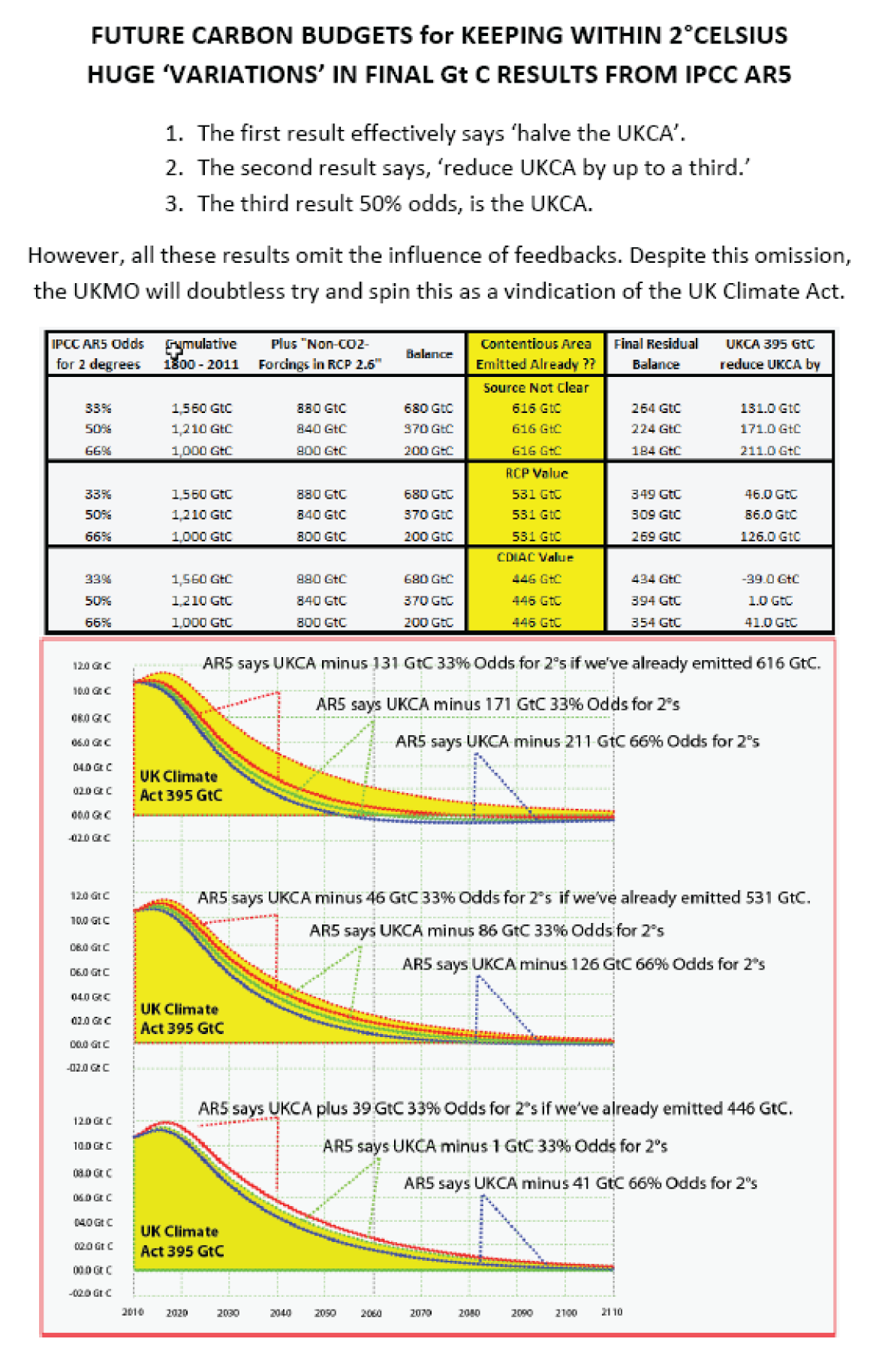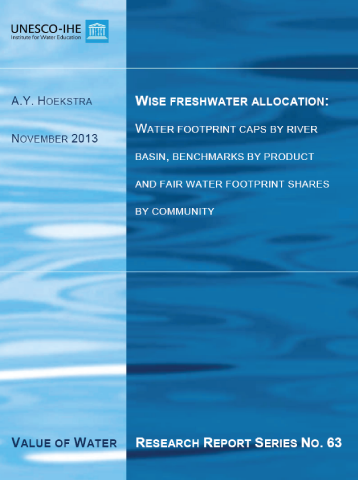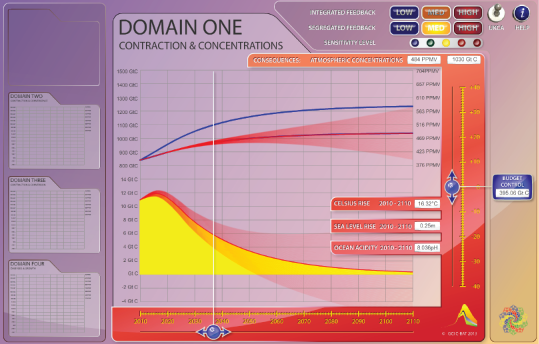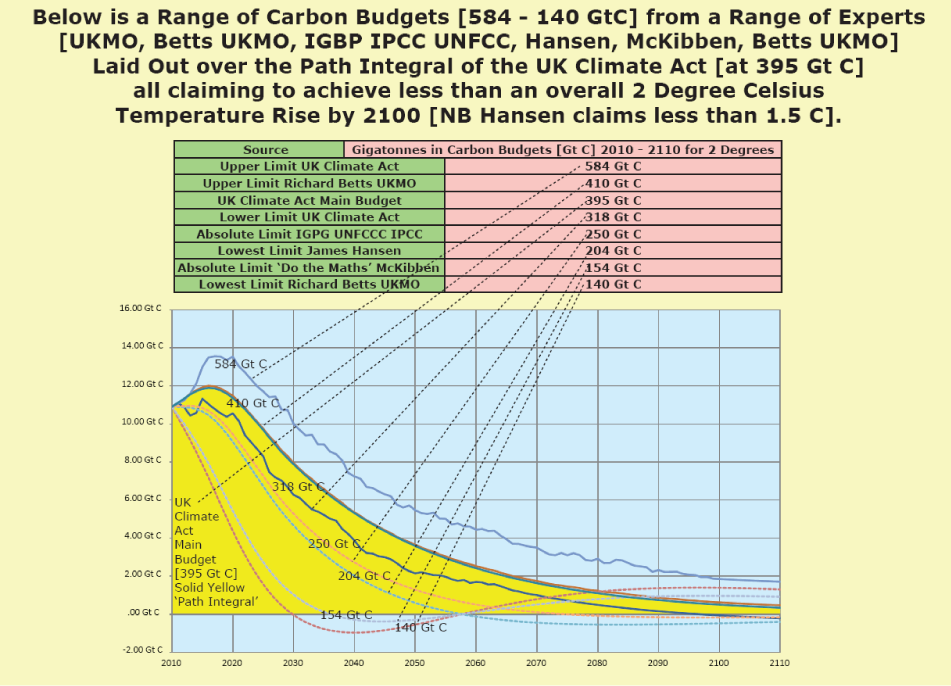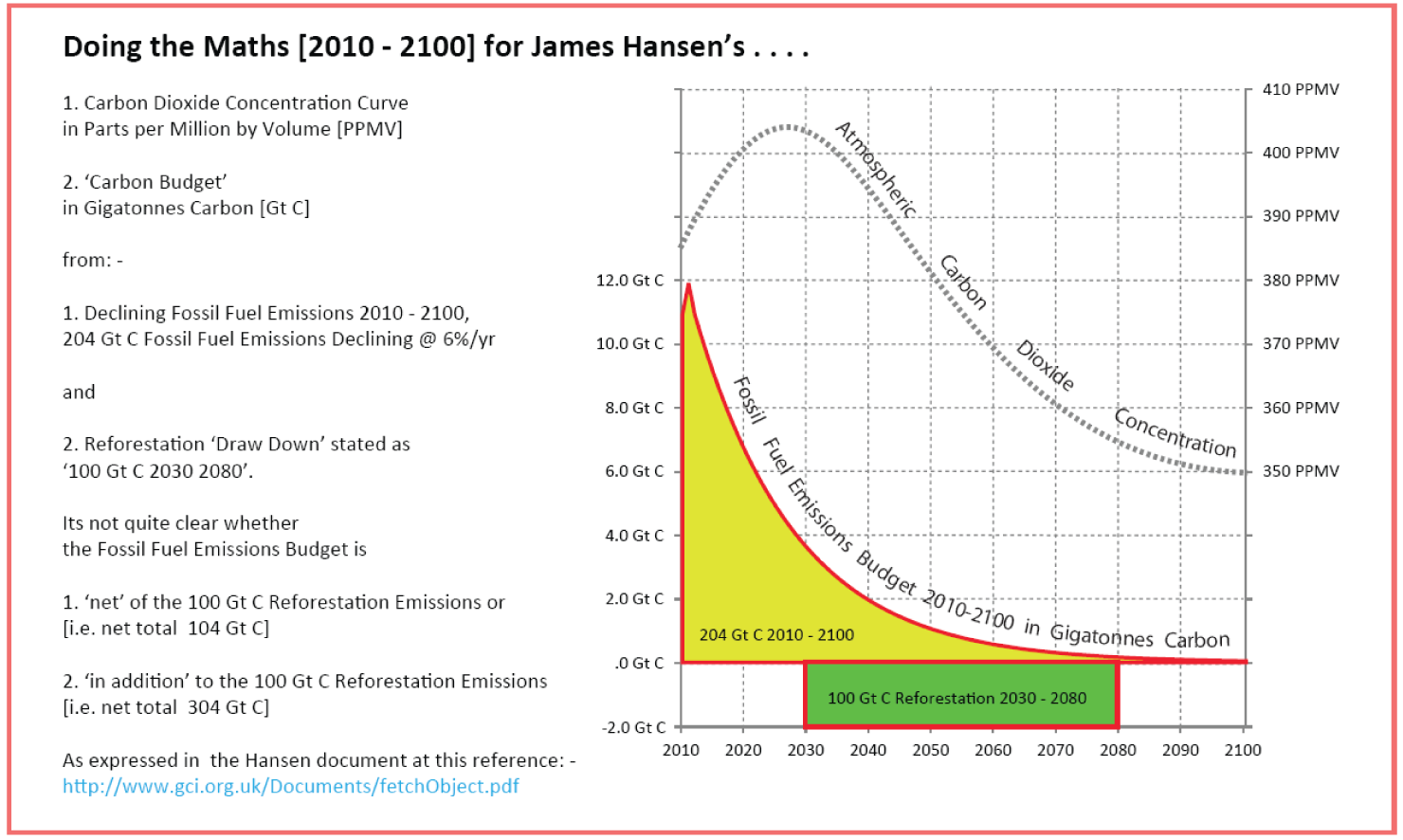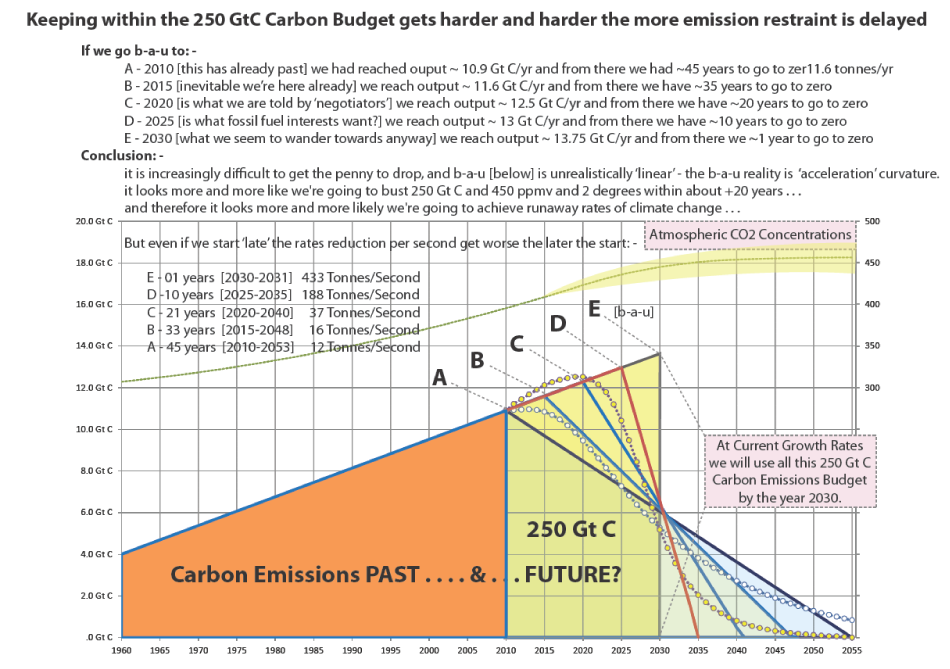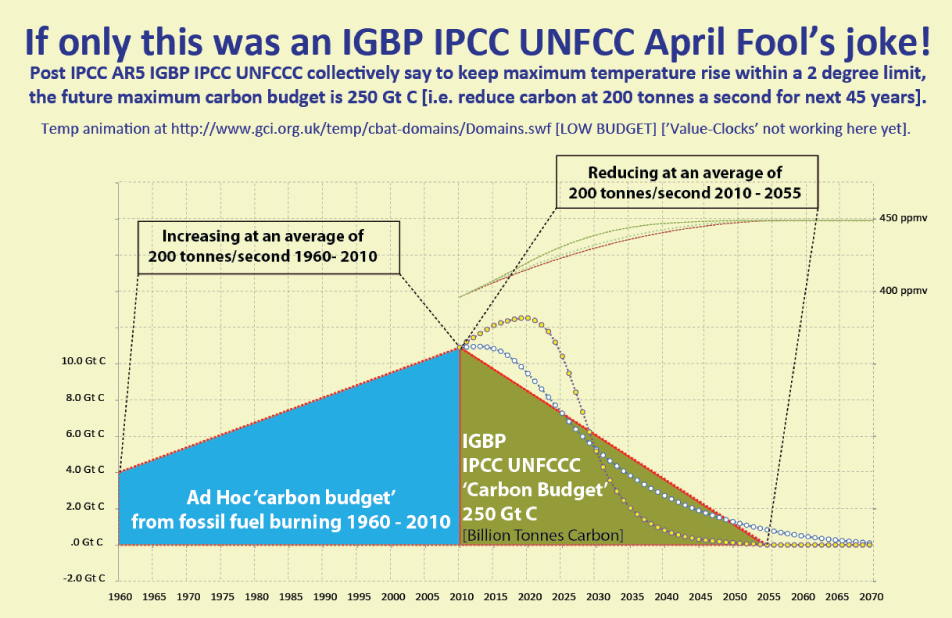Realising the Climate Convention Objective - Having decided on a choice of stabilisation level, a large question remains: how can the nations of the world work together to realise it in practice?
The Objective of the Climate Convention is largely concerned with factors associated with the requirement for sustainable development. In Chapter 9, four principles were enunciated that should be at the basis of negotiations concerned with future emissions reductions to mitigate climate change: -
- Sustainable Development
- Precautionary Principle
- Polluter-Pays Principle
- Equity Principle
This latter Principle includes intergenerational equity, or weighing the needs of the present generation against those of future generations, and international equity, or weighing the balance of need between industrial and developed nations and the developing world. Striking this latter balance is going to particularly difficult because of the grcat disparity in current carbon dioxide emissions between the world 's richest nations and the poorest nat ions (Figure 10.2), the continuing demand for fossil fuel use in the developed world and the understandable desire of the poorer nations to escape from poverty through development and industrialisation. This latter is particularly recognised in the Framework Convention on Climate Change (see box at the beginning of the chapter) where the growing energy needs of developing nations as they achieve industrial development are clearly stated.
An example of how the approach to stabilisation for carbon dioxide might be achieved is illustrated in the Figure above. It is based on a proposal called 'Contraction and Convergence' that originates with the Global Commons Institute (GCI) a non-governmental organisation based in the UK. The envelope of carbon dioxide emissions is one that leads to stabilisation at450 ppm (without climate feedbacks included), although the rest of the proposal does not depend on that actual choice of level. Note that under this envelope, global fossil-fuel emissions rise by about fifteen percent to about 2025; they then fall to less than half the current level by 2100. The figure illustrates the division of emissions between major countries or groups of countries as it has been up to the present. Then the simplest possible solution is taken to the sharing of emissions between countries and proposes that, from some suitable date (in the C02 Emissions Gross and Per Capita 'Contraction' for 450 ppmv & 'Convergence' by 2030 figure, 2030 is chosen), emissions are allocated on the basis of equal shares per capita. From now until 2030 the division is allowed to converge from the present situation to that of equal per capita shares; hence the 'contraction and convergence'. The further proposal is that arrangements to trade the carbon dioxide allocations arc made.
The 'Contraction and Convergence' proposal addresses all of the four principles mentioned above. In particular, through its equal per capita sharing arrangements it addresses head-on the question of international equity - and the proposed trading arrangements ensure that the greatest 'polluters' pay. It’s simple and appealing logic means that it is a strong candidate for providing a long-term solution. What has yet to be worked is how the 'convergence' part of the proposal can be implemented, but then any proposal for a solution will have to address the problem of 'convergence’.
31 December 2013 - "Climate Council Task would be to sort out C&C." Climate Challenged Society Dryzek Norgaard Schlosberg
Attracted by the comparative feasibility of minilateralism but worried about a small number of countries seen to be ordering the world, Eckersley proposes “inclusive minilateralism” in the form of a ‘global climate council’ composed of states that are most responsible for the accumulated emissions in the atmosphere, most capable of acting and representatives of the most vulnerable to the effects of climate change. Such a council might then be composed of the US, China, European Union, Russia, Japan, India, Brazil, South Korea, Mexico plus representatives from the Association of Small Island States, the African Union and the Least Developed Countries Group. It is the inclusion of representatives of these last three ‘most vulnerable’ categories of countries that distinguishes Eckersley’s proposal from more conventional minilateralism because the most responsible and most capable are also the largest emitters. The task of the Council would be to sort out long-term emissions reductions targets – essentially the shape of Contraction and Convergence – we introduce here: -
Climate Challenged Society
John S Dryzek, Richard B Norgaard David Schlosberg31 December 2013 - "C&C may be the only path to avoid disaster." Challenging the Orthodoxy Susan Schroeder Lynne Chester
Ecologically sustainable, socially just development could follow a scenario similar to a generalization of Contraction and Convergence proposed by the Global Commons Institute for GHG emissions. In the latter approach: -Contraction refers to the 'full-term event' in which the future global total of greenhouse gas [GHG] emissions from human sources is shrunk over time in a measured way to near zero-emissions within a specified time-frame..
Convergence refers to the full international sharing of the emissions contraction-event, where the 'emissions-entitlements' for all countries result from them converging on the declining global per capita average of emissions arising under the contraction rate chosen.The poor countries would initially increase their per capita emissions while transforming their economies and technologies, so that they could subsequently run their economies with near zero per capita emissions. The rich countries would rapidly reduce their per capita emissions to near zero, while assisting the poor countries in their transition. The convergence would eventually be achieved at an agreed date such as 2050 with the economies of all countries functioning with the same per capita emissions. Although it seems idealistic it may be the only path to avoid environmental disaster and socio-economic collapse.
Reaching international agreement on Contraction and Convergence would be very difficult. However the process could be commenced through agreements on limited specific policies that nations could undertake individually or in groups.31 December 2013 - "C&C will not be easy to agree but we need to avoid short-term fixes." Beyond 2015, Bio Regional
Executive summary
In simple terms, sustainable consumption and production (SCP) is about how people live their lives – what they need, what they consume and what they produce. It is at the heart of sustainable development because it enables people everywhere to live a good quality of life within their fair share of our one planet’s resources.
The UN Secretary-General’s High Level Panel on the Post-2015 Development Agenda concluded that the Millennium Development Goals (MDGs) fell short by ‘not addressing the need to promote sustainable patterns of consumption and production’. We cannot afford to repeat this mistake.
The post-2015 goals – and the accompanying targets and indicators - for sustainable development that will succeed the MDGs must contribute clearly and actively to this global shift to SCP. Similarly, we must ensure the post-2015 goals are people-centred and universal – they need to reach the hearts and minds of people from the UAE to Malawi and from Denmark to Haiti.
This paper sets out proposals for what these practical SCP-related targets and indicators might be, divided among likely key themes for post-2015 goals. If adopted, this would be a powerful way of integrating SCP into the global sustainable development agenda. We want to make SCP less of a talking point and more of a reality amongst the people who will help make it happen - governments, business and civil society.
Business as usual is not an option. Climate change, habitat destruction and over-exploitation of natural resources such as forests and fisheries are now doing great harm to human health, wellbeing and livelihoods, especially among poorer communities. This threatens catastrophic damage for future generations. It is our accelerating production and consumption of goods and services which is mainly to blame. We are reaching and breaching the earth’s limits, as is apparent from the evidence provided by the early stages of work on ecological footprinting and planetary boundaries, and the scientific advice of Intergovernmental Panels.
This paper calls for countries to get a better grasp on how much their citizens are consuming, per capita, of natural resources at the global level, taking into account international supply chains. These carbon, water, land and materials footprints should be compared with estimates of what level of sustainable global per capita consumption these natural resources could supply for the entire human population, with everyone entitled to a fair share.
Under this ‘contraction and convergence’ approach, the poorest developing nations would have headroom in which to increase their consumption, helping to bring their populations out of poverty. Developed countries would have to reduce their consumption of some critical natural resources, and so, eventually, would some nations which are now classed as middle income. There is scope for developing countries to achieve good standards of living by taking far less resource-hungry, wasteful and polluting paths of development than the developed nations did during the previous two centuries.
It will not be easy to reach agreement on such an approach. But we need to avoid short term fixes. Deep rooted systemic and structural renewal is urgently required if we are to achieve a just and fair transition to a more sustainable future. For this reason, we are supportive of new growth models, which go beyond GDP and strive to ensure that people can live happy, healthy lives within their fair share of the earth’s resources – or one planet living.
This over-consumption crisis brings great opportunities for new, global partnerships. Ban Ki Moon’s High Level Panel Chairs spoke of a new principle of “mutual accountability” in a constrained world.2 This report looks briefly at the role of business, governments and consumers in achieving the acceleration in SCP we need.
Governments have the greatest power to accelerate this shift. Politicians and governments can create the regulations, policies and market instruments that drive society towards SCP. Governments have a role in guiding our consumption, and many are already trying to learn lessons from the science of behaviour change in order to strengthen their existing levers.Business must also take a central role. To survive and prosper in the long term, they have to go beyond the profit motive and act as responsible member of communities that are local, national and often international. Some companies are already leading the way, sourcing sustainably and making it easy for their staff and customers to make informed and sustainable choices. We want more businesses to use their power to influence governments and regulation, be more transparent in their reporting, and to shape their consumers tastes and behaviours.
But we also need consumers to act and think like global citizens, adjusting their attitudes, values and behaviours to minimise the risk to future generations. This challenge will only get more pressing as three billion consumers are expected to enter the middle class by 2050, the vast majority from developing countries3. Many consumers are calling for a shift to SCP, organising through social media, unions and civil society organisations, and even showing the way through grassroots initiatives which provide inspiring practical examples of SCP.
In addition to new, global partnerships, achieving genuinely sustainable development will require significant technological innovation and the rapid, widespread transfer and implementation of technologies and know-how. We want to harness human ingenuity – evident in ‘high and hard’ technologies such as smart grids and lower-tech solutions such as bottle lights - for the benefit of all. This will mean building capacity, such as creating strong national systems of innovation and governments setting the right policy environment. Where the solutions are very expensive, or where there is a lack of capacity, developing nations are entitled to help from developed nations.
Like ‘sustainable development’, SCP is an extremely broad and much debated term. The post-2015 goals for sustainable development are likely to be wide ranging, addressing issues such as health, governance and education. However, this report has set out targets and indicators under the following likely key themes for post-2015 goals most closely related to SCP:
- Ending extreme poverty, reducing inequality, securing social justice
- Securing sustainable, clean energy for all with climate protection
- Food security, good nutrition and sustainable agriculture and food production
- Sustainable water consumption and management, achieving universal access to water and sanitation
- Protecting biodiversity and ecosystem services and ensuring sustainable natural resource management
The intention is that the proposed targets could be relevant under a number of different goal headings in a final framework. We hope that our proposals for these SCP-related targets and indicators can be used effectively and become a powerful way of making SCP less of a talking point and more of a reality for all.
30 December 2013 - "The higher the Contraction:Concentrations the higher the potential damage slope." CBAT Domain FourNot finished yet but the CBAT Domain Four animation will show this clearly
30 December 2013 - "Climate Equity, Emissions Reductions & what should be done about it." Prof Don Brown Widener University
Has Discussion Of What “Equity” Requires Of Nations To Reduce GHG Emissions Disappeared From Climate Negotiations?
If So, What Should Be Done About It?How To Make Equity Part Of National Responses To Climate Change
For the reason stated above, there is an urgent need to increase the focus in international climate negotiations and at the national level on equity and justice and simply ignoring these issues because they are difficult or contentious is likely a huge practical mistake that has potential catastrophic consequences. However, given the resistance thus far on nations’ willingness to openly discuss the equity and justice dimensions of their climate policies, the first order question is how to do this. Because of the unwillingness of nations to agree on what equity requires of them, initial steps should be taken to increase awareness of the ethical and justice failures of national responses to climate change.
1. The first priority is to achieve a wider understanding of the utter failure of national commitments thus far to deal with the equity and justice issues. The UNFCCC secretariat has the authority to ask nations specific questions. In the past, when the nations have been asked questions about their position on equity, the questions have been too general with insufficient follow up. Along this line each nation should be asked to answer a series of questions about their ghg emissions commitments which include but are not limited to the following:
- What specifically is the quantitative relevance of your emission reduction commitment to a global ghg emissions budget to keep warming below a 1.5 °C or 2°C warming target. In other words how does your emissions reduction commitment, in combination with others, achieve an acceptable ghg atmospheric concentration that limits warming to 2°C or the 1.5°C warming limit that may be necessary to prevent catastrophic warming?
- What is the atmospheric ghg concentration level that your target in combination with others is aiming to achieve?|
- How specifically does your national commitment take into consideration your nation’s undeniable obligation under the UNFCCC to base your national climate change policy on the basis of “equity.” In other words, how have you operationalized equity quantitatively in making your emissions reduction commitments?
- What part of your target was based upon “equity”?
- Are you denying that nations have a duty under international law to assure that:
- the “polluter pays”;
- citizens in their country not harm other people outside their national jurisdiction under the “no harm” principle; and,
- your country should have applied the precautionary approach to climate change policy since 1992 when the UNFCCC was adopted?
- How does your national ghg target commitment respond to these settled principles of international law?
- In debating national climate policy, to what extent have you apprised citizens of your country that nations have ethical and justice responsibilities to other vulnerable people and nations?
- To what extent have you informed high emitting entities and individuals within your nation that they have ethical responsibilities to decrease their ghg emissions in cases when this can be done without a major sacrifice to an entities or individual interest.
2. Because debates about climate change policy formation at the national level have often ignored questions of equity and fairness, there is a need to publicize how debates at the national level about proposed climate change policies acknowledge or ignore questions of equity, ethics, and distributive justice. To accomplish this, researchers around the world should be requested to report on and document how ethics and equity issues are being considered in public policy debates about national policy within each country. This analysis should determine, among other things, the extent to which the debate about climate policy has specifically considered an atmospheric ghg concentrations goal and on what equitable and distributive justice basis has the target commitment selected.
3. There is a need to establish an international data base on how nations have considered equity and distributive justice issues at the national level and specific excuses that nations have relied upon for their failure to support an ethically justifiable international climate regime.
4. The starting point for any negotiations session under the UNFCCC should be a submission by each government on their position on their equitable obligations for issues under negotiation. This submission should be detailed to include specific ethical issues under consideration during each negotiation.
5. Each nation should be required to identify what policy steps it is taking to provide, protect, and fulfill the human rights that may be adversely affected by climate change to both people in their own country and vulnerable people around the world.
6. As part of climate negotiations, each national commitment to reduce ghg emissions should be reviewed by a panel of experts who would evaluate each national commitment to reduce ghg emissions on its merits as a matter of distributive justice.
Donald A. Brown
Scholar In Residence and Professor,
Widener University School of Law,
Harrisburg, Pennsylvania
Visiting Professor, Nagoya University,
Nagoya, Japan
Part-time Professor, Nanjing University of Information Science and Technology, Nanjing, China24 December 2013 - Ave Maria, Kimi Skota 'Black Diamond'; Music in the Beloved 'Rainbow Nation', Greensward CivitasTuesday, December 24, 2013
A Little History
The structure of a piece such as this - Ave Maria - originally by Bach in The Well-Tempered Clavier, was adapted by Charles Gounod. It inspired Gounod to devise an improvisation of a melody over the C major Prelude (BWV 846) from the collection's first book. The structure of these pieces progress through the harmonics in different keys. Each set contains twenty-four pairs of preludes and fugues. The first pair is in C major, the second in C minor, the third in C-sharp major, the fourth in C-sharp minor, and so on. The rising chromatic pattern continues until every key has been represented, finishing with a B-minor fugue. It inspired Gounod to devise an improvisation of a melody over the C major Prelude (BWV 846) from the collection's first book. To this melody, in 1859, Gounod fitted the words of the Ave Maria, resulting in a setting that became world-famous. This exploration of musical structure is grounded in the fundamental scales generated from standing wave functions represented by relative string lengths.
Music has a unique capacity to move us, its harmonics resonating through our emotional centers and releasing the energies of the mind as well as the flesh. This kind of shared experience has the capacity to move us beyond our normal boundaries and engage us in a dynamic flow that becomes greater than the sum of its parts. Maybe this is the kind of experience that precedes and then builds the necessary synergy for reaching consensus on our human issues.
This idea was expressed long ago by William Congreve, in The Mourning Bride, 1697:
Musick has Charms to sooth a savage Breast,
To soften Rocks, or bend a knotted Oak.
I've read, that things inanimate have mov'd,
And, as with living Souls, have been inform'd,
By Magick Numbers and persuasive Sound.
What then am I? Am I more senseless grown
Than Trees, or Flint? O force of constant Woe!
'Tis not in Harmony to calm my Griefs.
Anselmo sleeps, and is at Peace; last Night
The silent Tomb receiv'd the good Old King;
He and his Sorrows now are safely lodg'd
Within its cold, but hospitable Bosom.
Why am not I at Peace?
23 December 2013 - "Is C&C a a good idea? 100% say yes . . . " I don't know who started this, but its off to a good start . . .23 December 2013 - "Canada must set the way with Contraction & Convergence" Durham CLEAR, Quebeq
To calculate these targets, Gignac applied the contraction and convergence theory of carbon emission reduction, established in 1997 during the Kyoto climate change negotiations. Under contraction and convergence, industrialized countries (including Quebec) must at first contract their emissions more quickly than industrializing countries, to make up for the historical over-exploitation of carbon used in their industrialization process. IRIS estimates that this contraction period should go on until 2050. At that point—assuming all countries have had a chance to increase their level of industrial development—all countries would then decrease their use of carbon at the same rate. For the province to meet this goal, there is a need for immediate and systemic action, said both Gignac and Prud’homme. For example, said Gignac, the provincial government’s favourable stance towards Enbridge’s Line 9B pipeline reversal, which could see tar sands crude piped to Quebec and refined in Montreal, will have an immediate, negative impact on Quebec’s emissions. “The refining process of oil from the tar sands is more polluting [than conventional oil] and it also results in residue like petroleum coke that is then used as fuel in cement factories. So the Quebec government does not seem to realize its responsibility in the climate crisis.”
Quebec's 11Mt Carbon Deficit Holds Lessons for all of CanadaThe Gignac Report [Original in French]
How to share the global carbon budget : the principle of contraction and convergence
Historically, grabbing natural resources is usually done according to the law of the strongest , during outbreaks imperialist colonial powers. Contemporary reality does not seem to be free demonstrations of strength for access to resources . Today, the limited absorption capacity of GHGs from the atmosphere has become a "resource" highly prized , states are challenged to share a civilized manner efforts to reduce GHG emissions , based on generally accepted principles of justice .
The concept of contraction and convergence of GHG emissions based on the concept of polluter pays and international equity . Developed by the British Institute Global Commons Institute , its theoretical framework was agreed at the Kyoto Conference in 1997. Often described as a solution of 'climate justice without vengeance ", he was considered " inevitably required "by the Conference Secretariat , United Nations Framework on Climate Change (UNFCCC ) in 2003 in Milan.
First, a key finding is the strong asymmetry between the per capita emissions · different countries ( as shown in Figure 2) . While the annual global average is 4.9 tons of CO2 per capita · e , the United States are responsible for 17.6 tonnes per capita · e , more than three times the global average. China, despite its high emissions in absolute balance sheet, just above the world average emissions , at 6.2 tonnes per capita. In addition , most developing countries, such as Algeria , Brazil and India show an emission of less than 4 tonnes per capita footprint · e . As for Quebec , bankruptcy emissions totaled 10.4 tonnes per capita · e , more than double the global average.
All peoples of the world aspire to a decent standard of living . Since carbon budget is limited, the developed countries must " make room " for developing countries by allocating an atmospheric space that allows them to reasonably develop their economies without undue constraints .
Thus, to meet the global carbon budget , states must first know the first phase of gradual contraction from 2000 to 2050 , during which developed countries must reduce their emissions drastically , while the required reductions in developing countries are less severe. Then, from the second half of the 21st century , the convergence phase will involve emissions per capita · e equivalent between states, assuming that the distinction "developed / developing countries" ultimately becomes obsolete ( please refer to the chart 3).
22 December 2013 - "We share a Common Destiny. This underlies the C&C Principle." Journal of Social Intervention
Since we humans all share a common destiny, all countries share responsibility for our global environment. However, there is a difference between industrialized countries and developing countries. Industrialized countries bear the greatest (historical) responsibility with regard to environmental issues, and also have the greatest means at their disposal to address them. In the interests of fairness, then, they should take the lead in adopting measures to address environmental problems. This is the principle of common but differentiated responsibilities, which plays an important role within international negotiations and underlies the idea of contraction and convergence (Global Commons Institute, 2011; Peeters, 2012b).
Sustainable Development; A Mission for Social Work; a Normative Approach
Prof Jef Peeters Leuven University College20 December 2013 - "Sustainable Development requires Love Option A is B-a-U; B is C&C the love-infused path." D McQueen IIED
Sustainable development requires an infusion of love
Duncan Macqueen 20 December 2013 Forests, Natural resource management
The New Year is a big one for planet earth. New Sustainable Development Goals (SDGs) will set our trajectory into an increasingly uncertain future. But country delegations are arguing over the wrong thing – says a paper entitled 'love-infused development' As a forester, I celebrate the ways forests contribute to the festive season: Christmas trees, holly wreathes, logs on fires, Boxing Day walks through the woods. But globally, forests are in trouble, and their fate is not unrelated to the consumerism that afflicts Christmas celebrations.
A fivefold expected increase in global consumers between 1900 and 2030 is dwarfed by a fifty-fold expected increase in consumption, from US$2 trillion in 1900 to US$100 trillion by 2030. There is a growing squeeze on forest land to meet this demand. Halting forest loss – which causes 17 percent of global carbon emissions – was heralded as the easy win in UN climate change negotiations. Perhaps not… Humanity's ecological footprint already exceeds by 50 per cent the area actually available to produce renewable resources and absorb carbon dioxide.
So we live in interesting times. For people and the forests we depend on to share this planet of ours, we must cut overall consumption, and there are two basic options open to us.
- Option 1 is more consumption for the favoured few and increasingly critical deprivation for the rest (constrained business as usual).
- Option 2 is contraction and convergence towards a more equitable consumption patterns (universal development goals).
The latter is clearly the love-infused path – but how on earth can we bring it about?It is that question that is vexing UN Secretary General Ban Ki-moon and others tasked with designing this new universal set of development goals to replace the Millennium Development Goals (MDGs) that end in 2015.
Any new Sustainable Development Goals (SDGs) or revamped MDGs would be New Year's resolutions on a planetary scale. But the process from which they will emerge is a dark art – a United Nations cauldron presided over initially by a High Level Panel of Eminent Persons, and now by endless sessions of Open Working Groups that sift and stir 'priority areas' into the bubbling froth.
Activists marshal a motley mix of interested parties and expert evidence to smuggle in their pet themes – food security, water and sanitation, energy, health, gender and so on. It will gradually boil down into a handful of pithy goals and indicators. None of it, frankly, is likely to make a blind bit of difference — we already know what has to be in the mix.
Countless academic tomes have been written on human needs, values, capabilities and rights. They fall into at least six categories: natural and cultural heritage; material health and wellbeing, affirmative social relationships; present and future security; the potential for creative fulfilment and; a sense of identity and purpose. As I argue in a new paper, country delegates influencing the SDG process have the wrong thing in their cauldron. That's because whatever the mix of priority areas, it matters far less than how that mix is pursued.
For any given goal, polar opposite results are possible, depending if it is pursued selfishly or selflessly. Yet much of the economic machinery of business and nation states is set up for the former – giving more to those who already have too much (Option 1 above). To overcome this we need SDGs that are explicit in how they will encourage the machinery of business and governance to deliver more equitable and universal outcomes (Option 2).
As my recent paper and a two-page backgrounder show — the designers of these goals need to seriously rethink them, based on love, not selfish greed. We need love-infused development goals. Rather than focusing on what priority areas must be in the mix, the SDG design process should debate how best to pursue them. That debate would be difficult and contentious– but to kick it off, how about the following as SDGs (with indicators of progress to follow)?
- SDG 1. Inclusive resource rights and land use planning processes
- SDG 2. Locally controlled business models and health systems
- SDG 3. Federations that represent localised democracies
- SDG 4. Redistributive justice backed by fair judicial systems
- SDG 5. Public entrepreneurial education and family support systems
- SDG 6. Service oriented, gendered business and peer rewards.
Duncan Macqueen's new IIED paper argues that the mix of SDG priority areas matters less than how that mix is pursuedDuncan Macqueen's new IIED paper argues that the mix of SDG priority areas matters less than how that mix is pursued
Such goals would enable humanity to pursue fair and sustainable development for the masses, not the few. I got a glimpse of what can happen when policymakers follow that path last week, when I had the good fortune to attend a forestry conference in China.
China is of course ahead of the game. As I reported in my blog post for IIED:
- China's reforms of forest tenure over the past five years have granted 90 million forest farmers with licenses to manage their land
- Such farmers planted about 70 per cent of the 29 million hectares of land reforested in China between 2000 and 2010, cutting the net global rate of forest loss by almost one third
- Some 115,000 forest cooperatives have formed
- Total forest sector output is reported at a staggering US$650 billion – much shared locally. More than 1,000 centres now deal with disputed land titles and trading
- China has rolled out forest insurance at breathtaking pace and invested in capacity development – including in traditional agricultural knowledge, understory crops and eco-tourism.
It's not all perfect – but I'll wager that a higher percentage of rural people in China have reason to cheer in their New Year than their British counterparts do this festive season.
It is a time for celebration and reflection – not just a Santa sack of consumer goodies and a hung-over New Year promise of 'never again'. Christmas celebrates the birth of one whose command was simply 'love one another'. It's a message that has much to offer to the bureaucrats and diplomats tasked with steering humanity to a sustainable future.
Duncan Macqueen is Principal Researcher in the International Institute for Environment and Development's Forest Team (duncan.macqueen@iied.org) Themes: Forests, Natural resource management.
20 December 2013 - Tree of Peace by Oren Lyons & The Great Law of Peace and the Planetary Crisis - Jack P Manno
The Tree of Peace by Oren LyonsThe Iroquois Tree of Peace" by Oren Lyons, Onondaga
The white pine grows very tall and straight and so can be seen from a great distance. It is an evergreen and so is vibrant all year. It has leaves that look like long, slender needles. Those needles grow in clusters of 5 reminding us of the unification of the Five Nations.
The people were asked to throw their weapons of war into the pit where the tree had been. At the bottom of the pit was an underground river that carried the weapons away so that future generations would not see them. That action symbolized the hope that there would be no war in the future. The tree was then put back in the ground. It is referred to as The Great Tree of Peace.
It has four white roots that extend to the north, south, east and west of Turtle Island aka North America. The roots are called the White Roots of Peace and are an invitation to other nations to follow them to the sheltering branches of the The Great Tree of Peace. The Peacemaker placed an eagle atop The Great Tree of Peace. The eagle can fly very high and has keen eyesight. The eagle is the guardian who warns of any approaching danger to the peace of the Haudenosaunee.
The Great Law of Peace and the Planetary Crisis
Jack P. MannoLike many PNL readers, I yearn for a social and political system that promotes peace, justice and environmental responsibility. As an Tree of Peace by Oren Lyons activist I’ve worked to agitate and organize for those values. As a scholar at SUNY College of Environmental Science and Forestry, I’ve analyzed the economic forces behind environmental destruction and the politics that collude with them and asked, what kind of governance could halt the planetary crisis and reign in the destructive political economy that dominates the planet.
In my search for a model, I have found nothing better than what began over a thousand years ago on the shore of Onondaga Lake. A man known as the Peacemaker (Deganawidah) inspired the leaders of five warring nations to bury their weapons beneath the tree of peace and form a confederacy. Incredibly, that confederacy, under assault for nearly half of those thousand years, continues to deliberate at its capital — the Longhouse in Onondaga – making it arguably the longest continually functioning democracy in the world.
Because of the courage, persistence and generosity of Haudenosaunee leaders and teachers, we can ask: what might governance look like if it were modeled on the Haudenosaunee constitution, the Great Law of Peace (Gayanashagowa)? Haudenosaunee history tells us that the roots of the Tree of Peace grew out from Onondaga in the four directions; that any nation or people can follow those roots back to their source and, if they are willing to live by the Great Law of Peace, they will find shelter there.
We might consider following those roots to find governance that works for the Earth. Where else should such a step begin but in Onondaga country? On Monday October 4, 7:00 pm, at Syracuse Stage, I have the honor of joining Audrey Shenandoah (Onondaga) and Tom Porter (Mohawk), two remarkable teachers and Haudenosaunee leaders, for a conversation on the Great Law, its history and relevance for today.
The Haudenosaunee formed the best known and longest lasting of the many Indigenous confederacies in North America. The Great Law is a comprehensive international agreement involving all aspects of Haudenosaunee collective life. It requires respect and gratitude to the natural world and consideration of the impacts of decisions on future generations.
I interpret the following principles from what I have learned from Haudenosaunee teachers and academic historians.
- Righteousness. Also known as the “Good Mind,” an alignment of one’s mind with natural law and the welfare of one’s Clan and Nation.
- Diversity within unity. Unity is necessary for individual and national development. Each individual has a responsibility to find and nurture one’s special gifts given by the Creator, and the community is responsible to help one identify and cultivate those gifts. Freedom.
- Freedom from want, from coercion and violence. Freedom of speech and freedom of religion.
- Consensus. There is an expectation that extensive public debate will lead to consensus and the requirement that the process continue until it does.
- Checks and Balances. A complex system of checks and balances exists between nations, clans, war chiefs and peace chiefs and between women and men.
- Gratitude. All meetings and important events begin with the “Thanksgiving Address,”a ritual oration in which each element of Creation is thanked for continuing to perform its duties and thereby making life possible.
- Clear Responsibility for the commons. The Great Law of Peace distinguishes between who is responsible for the land and resources in settled areas—the women— and who in the “woods,”—the men. Proper behavior and responsibility in both is delineated.
- Open borders. People have full rights in any of the Nations, except the right to hold high office, and that too can be granted to an individual through the designated process of appointing leaders.
- Families and Clans as fundamental social structure. Perhaps the most important social institution is the clan. Through the clans, which cross the six nations, international relations become family relations. All authority springs from them. Issues are discussed within the clans and presented to a clan council made up of women. The clan council selects the clanmother who chooses the chief to represent the clan in council. The process of selecting chiefs begins very early when a young boy is observed, importantly for how he treats women and girls. Everyone is born into one’s mother’s clan.
Applying These Principles Today
Below are my thoughts on how to apply principles from the Great Law today:
- Gratitude, duties and healing. Because many who came from Europe fled a long history of harsh treatment and oppression, our founders emphasized individual liberty and rights. Yet the environmental crises require everyone to grasp our total dependence on healthy ecosystems, air, water, sunshine and the rest of Creation. Instilling within the institutions of global governance a ritual expression of gratitude as part of all decision-making meetings could help make gratitude and responsibility a part of everyone’s awareness. A covenant that expresses the duties required of all human beings to live lightly and responsibly (like the Earth Charter, www.earthcharterinaction.org/content/) should be a foundation of any new institution.
- The central role of female authority. Systems that ensure women’s active and equivalent participation with men should be designed into new institutions.
- Commons and ecosystem services. It is essential that new institutions recognize and support local control and responsibility for land and resources and in particular recognize Traditional and Native Peoples’ rights and responsibilities for their homelands. This is particularly important if mechanisms to pay environmental caretakers for the work involved and riches foregone in maintaining and sustaining “exploitable” natural resources are utilized.
- Sovereignty in an interdependent world. The Great Law clearly distinguishes between decisions of the Clans and families and decisions to be made by the Nation or the Confederacy. Outside of a fairly narrow range of decisions affecting the wellbeing of all the member nations, the Confederacy has little authority over the individual nations. The new institutions need to have a narrow mandate focused on international cooperation in environmental restoration and protection.
- Clan identification. The clan system is the most difficult to imagine in our new environmental institutions. We might create international member organizations for distinct responsibilities. Membership could entail rights as well as duties, such as river-keepers, wolf allies, soil builders, foresters, midwives, tree doctors, keeper of the ceremonies, etc. A portion of a person’s political representation might function through these clan-like groupings linked internationally. Remembering that the essential feature of the clan system is that everyone is born into one’s mother’s clan, mechanisms would be required to institutionalize female authority and matrilineal rights.
The new institutions should include a commitment to the UN Declaration on the Rights of Indigenous Peoples. By recognizing and honoring the rights of indigenous peoples in all its deliberations, the new environmental institutions will communicate and collaborate with Indigenous Nations based on mutual respect, equity and empowerment.
The Haudenosaunee Environmental Task Force, the environmental organization serving the Confederacy, has drafted an environmental protection process. It proposes three questions to guide decision-making: What effect will our decision have on peace? What effect will our decision have on the natural world? What effect will our decision have on future generations? That sums up the meaning of the Great Law of Peace as a model for environmental governance.19 December 2013 - Answers to Questions by Prof Don Brown of 'Climate Ethics' Widener University [Fmr US Delegate UNFCCC].Professor Don Brown writes: -
As I watch this discussion [about carbon budgets etc] from the United States, I have a question which might be an important one or perhaps not.
- When the UK government refuses to revise its target, on what normative basis is it supporting its position?
They appear not to have an answer, which is apparently why they say we don’t need to answer.
This is rather like the contrarians who tactically argue why have a ‘solution’ to a ‘problem’ that doesn’t exist!
- Every national target is implicitly a position on what the nation's fair share of safe global emissions.
Exactly – and though Government and Non-Government actors are reluctant to admit it, this has been patently obvious from the word go.
- This means [stating the obvious] my target is implicitly a position on a safe atmospheric concentration of GHG as well as that nation's fair allocation of the atmospheric concentration.
It is precisely because this truth is unavoidable, even if it has not been ‘self-evident’ to Government and Non-Government actors, that CBAT [the Carbon Budget Analysis Tool] is being created to bring that out.
- All governments should be forced to explain what atmospheric ghg concentration stabilization goal will the atmospheric concentration the target will achieve as well as what the nation is assuming is its fair share of a budget that will get to that target.
The hope is that CBAT will make it easier for them to come to that order and forge an agreement in terms of that Syntax: -
1. What Concentration Target? 2. What Budget? 3. What International Sharing Principle?
- Most nation's are putting forth targets without having to take a public position on what [a] the atmospheric ghg concentration level will be achieved by the target [b] given its assumption of what its fair share of a budget is.
For the last twenty years Government have asserted positions almost randomly, without any defensible reference to assumptions of ‘fairness’ - as in [b] - let-alone atmospheric concentration outcomes - as in [a] – though together [a] & [b] represent [or should represent] the objective [which we are committed to achieve] and the principles [which we are committed to apply] of the UNFCCC.
- We must force nations to say expressly what atmospheric concentration level is their target designed to achieve and how they have taken "equity" into account.
Since 1990 it has been GCI’s view, supported by the first model of ‘Contraction and Convergence’ introduced at COP-2 UNFCCC in June 1996, that however tough it may be, such a procedure is unavoidably necessary if the process as a whole is to succeed.
- My question is what expressly is going on in the UK about this - How is this being debated in the UK?
Be in no doubt that this important question has a clear answer.
The UK passed the ‘Climate Act’ into law in 2008. This was a response to the ‘Key Recommendation’ in their Report ‘Energy the Changing Climate’ written in 2000 by the Royal Commission on Environmental Pollution which read: -
"The government should press for a future global climate agreement based on the contraction and convergence approach, combined with international trading in emission permits. Together, these offer the best long-term prospect of securing equity, economy and international consensus."
The Chairman of the Climate Change Committee in 2008 [Lord Adair Turner] made various statements confirming the C&C structure of the Act saying, "The only sound strategy is C&C."Appropriate UK contributions to global emissions reductions
"The appropriate UK share of a global emissions target involves ethical judgements and will be the subject of international negotiations. A range of methodologies for allocating emissions reductions between countries have therefore been proposed. Most of these methodologies base emission reduction targets on per capita emissions, abatement costs or income. They differ in relation to the time when different countries begin emissions reductions, the rate at which they then reduce emissions, and the extent to which already industrialised countries should have to compensate for historic emission levels.
It is not part of the Committee’s remit to propose a specific methodology for the purposes on international negotiations. But we believe that it is difficult to imagine a global deal which allows the developed countries to have emissions per capita in 2050 which are significantly above a sustainable global average. In 2050 the global average, based on an estimated population of 9.2 billion, would be between 2.1 to 2.6 tonnes per capita, implying an 80% cut in UK Kyoto GHG emissions from 1990 levels."
Lord Adair Turner - Chairman UK Climate Change Committee - Letter regarding theCreation of UK Climate Act to Minister of Energy and Climate Change [07 10 2008] [UK Climate Act]
"Climate change is likely to impose massive economic costs. The case for being prepared to spend huge resources to limit it is clear,” says Turner, arguing that the cost will be repaid many times over by the avoidance of disaster. In any case, “the developed world does not have the moral right to increase the risk of flooding in Bangladesh”, and, he adds acidly, “European executives worried about the cost of action should perhaps consider it the necessary price for preserving at least some skiing in the Alps. Long term the only sound strategy is that of ‘contraction and convergence’ – cutting greenhouse emissions to the point where they are shared equally, worldwide, on a per capita basis.”
Lord Adair Turner - Chairman UK Climate Change Committee - Interview in Green Futures
Adair Turner characterised the UK Climate Act as C&C in evidence to the EAC and DECC select committees in 2009 saying that converging to equal per capita entitlements globally is the only option that is, "doable and fair" for organising and sharing the full-term emissions-contraction-event to bring us to UNFCCC-compliance. He agreed that, "if, for reasons of urgency the rate of global contraction has to be accelerated, for reasons of equity the rate of international convergence has to be accelerated relative to that.”
Evidence to House of Commons - Climate and Energy Committee
"Dear Mr Meyer, May I say that I have always had great admiration for the role you have played in proposing the broad principle that "convergence" of per capita emissions will in the long-term be reached."
Lord Adair Turner - Chairman UK Climate Change Committee - Personal Letter to GCI, 16th June 200918 December 2013 - "I am not peddling nuclear power but . . . " Jim Hansen really let's it all hang out . . . [Maybe he's got a point?]This from an email list with a lot of people on it [I guess who better remain nameless . . . . ]
We will need contributions from practically everything, i.e., energy efficiency, renewables, nuclear power, and likely even carbon capture. It is not necessary to debate these. Instead they should be allowed to compete and different countries are likely to take very different paths, in part based on what natural resources they possess and in part on predispositions of various origins.
The essential requirement is a rising across-the-board fee on all carbon-based fuels, collected at the source (domestic mine or port-of-entry). A corollary, at least in democracies, is that the money should be distributed to the public, equal amounts to all legal residents -- allowing people to deal with higher energy prices, providing some relief from the tendency for the rich to get richer and poor to get poorer, as wealthy people tend to have larger carbon footprints, and providing some incentive for everyone to reduce their carbon footprint, incentives for entrepreneurs to develop low carbon and no-carbon products, and advance knowledge for business people for making investments in their business.
Not one dime should go to the government to make it bigger, and the government should not be making technology decisions that should be in the public's hands, e.g., subsidies for solar panels or "renewable portfolio standards" that force all the other people to pay for those who "buy" them. (As for renewable energies, I am all for these where they make sense -- the solar panels that I had installed on our barn produce twice as much energy as we use; we investigated a windmill, but its not allowed on our small property and from other things that I have learned I am glad of that; we probably will do geothermal if/when I have the money, but it is a money losing proposition on an old house such as ours, even with subsidies).
As for nuclear power, it is sorely needed in China and India -- China seems on the verge of building a large number of syngas plants, making gas from coal, which, when burned in a power plant (for the sake of reducing local air pollution), results in about 50% more CO2 than direct coal burning! It is a tragedy that Jimmy Carter squelched nuclear R&D and then Clinton practically eliminated it in the U.S.
If that had not happened we would now have the option of much safer more efficient 3rd generation (light-water reactors that shut down in case of an anomaly and can have cooling systems that do not require external power) and 4th generation reactors ("fast" reactors that can "burn" nuclear waste, excess weapons material and depleted uranium, utilizing more than 99% of the energy in the nuclear fuel rather than <1% as in today's reactors). These technologies mean that the nuclear fuel that can be sieved from the ocean is enough to last billions of years, i.e., it is an inexhaustible energy source -- the only reason to continue mining uranium on land is that it is cheaper to get it that way while large deposits remain.
The one remaining argument against nuclear (there is one nuclear "expert" in each environmental group peddling this) is that "fast" reactors would be harder to make proliferation resistant; that's a bogus assertion -- there are ways to do 4th generation that make it harder for anyone to get their hands on nuclear material than with existing technologies. Rogue states can get nuclear material with existing technologies -- we will always need international watchfulness, and fortunately the technology requirements are sufficiently complex that rogue states cannot hide such an operation and it is beyond the capabilities of non-state terrorist organizations. Because the U.S. essentially bailed out of R&D we now have Russia peddling their "fast" reactor capability (seven nations are already testing 4th generation capability) -- it would have been far smarter for the U.S. to continue to lead technology development and make it as safe as possible.
However, I am not peddling nuclear power -- if you are happy with the amount of energy you are getting in other ways, that is great, provided you phase out your fossil fuels. It is just that I do not see how China (which has taken on the task of producing products for essentially the entire world) can get off coal without the help of nuclear power. Finally, if you belong to the anti-nuke religion and any of this information is disquieting, I apologize and offer you the attached concert as a restorative gift. [Picture supplied].
I only suggest that you not tell the lady who says "put that in your hat and smoke it" that pollution from coal kills more people in a single day than nuclear power has killed in history, as she might hit you with her purse. And do not tell the lead singer, who chooses indoor wood fires, that the people killed by indoor biosphere fuels are exceeded only by those killed by coal. The only thing that really bothers me about their kool-aid is that they are trying to pour it down the throats of my dear grandchildren.
17 December 2013 - Fmr US Delegate Don Brown's brilliant response to Hillman with an 'Eagle' [actually so good, its a 'Condor'].As I watch this discussion [see Hillman to Hansen below] from the United States, I have a question which might be an important one or perhaps not.
- When the UK government refuses to revise its target, on what normative basis is it supporting its position.
- Every national target is implicitly a position on what the nation's fair share of safe global emissions.
- This means, stating the obvious, any target is implicitly a position on a safe atmospheric concentration of ghg as well as that nation's fair allocation of the atmospheric concentration.
- All governments should be forced to explain what atmospheric ghg concentration stabilization goal will the atmospheric concentration the target will achieve as well as what the nation is assuming is its fair share of a budget that will get to that target.
- My question is what expressly is going on in the UK about this.
- Most nation's are putting forth targets without having to take a public position on what the atmospheric ghg concentration level will be achieved by the target given its assumption of what its fair share of a budget is.
- We must force nations to say expressly what atmospheric concentration level is their target designed to achieve and how they have taken "equity" into account.
- How is this being debated in the UK??
17 December 2013 - Dr Mayer Hillman writes to Dr James Hansen confirming agreement re the need to revise the UK Climate ActDear Jim,
I hope that you have had time to consider what’s going on here in the UK as set out in the email below from GCI yesterday.
I am sure that you must be appalled to read that our Government rejects the need to revise the dates and targets for carbon emissions set down in the 2008 UK Climate Act, flying in the face of the IPCC’s latest calculation on the weight of the global carbon budget remaining if we are not to breach the 2.0C degrees ceiling – let alone the evidence you gave to the Environmental Audit Committee here in June and the 1.5C that you advocated.
As you can see in the following graph prepared by GCI, while the UK Government claims to lead the world with this Act, it is quite clear they are out of touch with the adjusted response of the scientific community to the reality of the rates of climate change that are already manifesting themselves: -
I have no doubt that you agree that, at such a critical time in our history, scientifically-based rather than politically-based decisions affecting the future must be taken. This is especially true as the scale of the societal changes needed is so challenging and certainly as any further delay in responding to this can only result in reducing the time for reason to prevail.
Once the most realistic carbon budget is set, the application of GCI's C-BAT model will point the way to focusing the strategic debate on how the sharing of the budget is to be negotiated internationally, thus holding implementation of transition measures to evolve, subject to that limit for compliance with the objective of the UNFCCC. Since the stated intention of achieving a meaningful 'global deal' on climate change by COP-21 in 2015 in Paris is not far off, the need to state and consolidate a focus much nearer to the rates of decarbonisation that you advocate is upon us all now. Without C-BAT all the debate and negotiation at UNFCCC around the matter of UNFCCC-Compliance retreats into picking numbers out of a hat.
Tension is growing here about this issue. From the corporate to the campaigning communities, there remains a pervasive ignorance about the weight and rates of 'carbon budgets', and the huge discrepancies between the budget in the UK Climate Act and what scientists such as yourself and those in the IPCC are declaring to be necessary. A clear and quantitative statement from you is needed on the extent to which this budget must be revised. Given your international stature in spelling out the world’s plight in this regard, will you comment publicly on why the UK Government must revise its figures?
Kind regards,
Mayer
16 December 2013 - Claims by the Climate Change Committee that the UK Climate Act 'leads the world' rest on this . . .
Without CBAT all the debate and negotiation at UNFCCC around the matter of UNFCCC-Compliance, retreats into picking numbers out of a hat.15 December 2013 - Climate Com. Chair Gummer, won't revise UKCA to IPCC & consults for Sancroft the 'trusted advisor' to . . .
Sancroft is the 'trusted advisor' to 'a host of [these] leading companies'.Climate Change Committee Chairman John Gummer [Lord Deben i.e. a member of the House of Lords] is a consultant to Sancroft.
Tom Burke, John Gummer's former political assistant, is an associate-director of Sancroft.Here's how Sancroft describes its approach . . .
"We act as a lens for our clients, enabling them to see a clear and simple path for their company through the increasingly complex world of sustainability.
- Foresight – Through our deep understanding of sustainability issues and our monitoring of media, NGO and government activity, we ensure that our clients stay up-to-speed on emerging corporate responsibility issues which affect them and their peers, allowing them to act quickly.
- Strategy – We work with our clients to develop sustainability strategies which respond to the challenges that they face and make the most of available opportunities. Our focus is on delivering strategies which are aligned with the values of the client and which are robust, practical and commercially driven.
- Execution – We work with companies to implement sustainability strategies across their business in a way that ensures best possible results in terms of simplicity and cost-effectiveness, and in terms of having a lasting positive impact.
- Communication – We develop and implement reporting and communications strategies which enable companies to engage effectively with all of their stakeholders, both internal and external, on the full range of issues that matter to them, and which also enable companies to gain maximum advantage for their performance in the sustainability arena.
- Crisis management – We help businesses respond to serious and immediate threats to their reputation, sales and operations. We then make sure that the necessary systemic changes are made within the business to ensure that any self-inflicted crises are not repeated."
You can't help ask the questions . . . .
Have Sancroft advised these clients that: -
- the UK Climate Act is need of urgent revision?
- the Carbon Budget for 2 degrees of 395 Gt C needs to be revised downwards to at least to the 250 Gt C that IPCC/IGBP/UNFCCC say is the maximum permissible for 2 degrees,
- while drawing attention to the 171 GtC that James Hansen says is necessary.
If the answer is 'no they haven't' - would it be any co-incidence that the Climate Change Committee won't revise the UK Climate Act?
If the answer is 'yes they have' - they why haven't they revised it? [Is up to God to do it?]?To think that Tim Yeo MP was up in front of the beak for a possible conflict of interest because he'd invested in some renewables.
He was completely cleared. Its not so clear that these people would be, but then I'm not a lawyer . . . .
15 December 2013 - Trading away your 'solution' with someone who pretends there's no 'problem' is daft. Lords Deben & BlabyJohn Gummer [Lord Deben] Chairman of the UK Climate Change Committee says he has such a hard time with Nigel Lawson [the climate contrarian Lord Blaby] that the recent CCC /decision/position not to revise the UK Climate Act is because they have to hold the line against the attacks from Lord Blaby and all that.
Its not a good argument. If there's a problem, we have to respond to the problem, not trade it away with someone who says it doesn't exist!
However the bottom-line for Lawson et al is not 'scientific' at all. It is this completely [and only] political argument [which is circumstantial evidence of pretence]. It was summarised after a recent 'strategic meeting' of the two sides [as reported in the Spectator]:-
"What was clear, however, was that they had no understanding of, or interest in, the massive human and economic costs involved in the policies they so glibly endorse."
Very revealing. In a funny way, that may be partly true . . . because CCC/UKCA community don't [or don't dare to] take climate change seriously enough, they don't see the scale of change needed, they go on trying to ease it by stealth into the pro-fracking business-as-usual of Osborn-omics . . . .
And that's how Lord Blaby and other contrarians 'win'. They just paint defenders of the Climate Act [Gummer/Hoskins and co] into the corner of uncaring ignoramuses [who have already caved in to the Treasury anyway].
Neat! So the 'problem' doesn't exist because the one's who say it does don't care enough.
George Orwell would have written about this something like this
Presumbaly, contrarians fossil-fuel the business-as-usual line as here [and see below], while climate realists would fuel it with renewables as much and as soon as they can. . . if only they could . . .
The headline choice for them is 'which budget'? Trading that choice away with Lord Blaby and his colleagues is daft. And the clear and present danger of doing too-little-too-late is dire.
and Which Budget? (page two of the above)
14 December 2010 - CBAT "This peerless and quite beautiful device." Jelle Hielkema The Rainbow - Ex UN FAO
Coming from Music, the purest expression of Nature, Aubrey Meyer has put his energies for the last 24 years into formulating, giving shape to and also getting very substantial support for, a solution to the challenge presented by the global climate changes which we are all now facing and which so seriously threaten our future. This solution is called 'Contraction and Convergence (C&C).No-one has framed and communicated the response strategy for negotiating and achieving compliance with the objective of the UN Framework Convention on Climate Change more perfectly than Aubrey with GCI's C&C concept and camapign.
The support for this is already extensive and diverse.
And now C&C has been developed into the rigorous Carbon Budget Analysis Tool (CBAT). Having done-the-maths, this peerless and quite beautiful heuristic device is user-interactive . . . .
See more
15 December 2013 - "C&C offers the best hope of addressing climate change & social inequity." Editor British Medical Journal
"I agree with Robin Stott that a global policy of “contraction and convergence” offers the best hope for our future, addressing climate change and social inequity (doi:10.1136/bmj.e1765). But the political will to achieve this remains elusive. Public engagement and greater efforts to convince politicians will be needed to keep climate change high on the political agenda when the problems of the global economy are so pressing. The question is, can we find a new economics that doesn’t rely on environmentally catastrophic growth, and can we find it in time?"14 December 2013 - Lord Deben [Gummer] & the row in the House of Lords . . . & blunt open letter . . .Lord Deben
cc Jim Hansen + ~50 others
Recent Decision by the Climate change Committee not to revise the UK Climate Act [UKCA]
For the UK Climate Change Committee (CCC) to say there are no grounds for revising the UK Climate Act (UKCA) Budget at this time, actually beggars belief. To cite the IPCC Fifth Assessment as part of the justification for this beggars belief even more.
IPCC, UNFCCC & IGBP co-published a statement in October, in other words only on month after AR5, that 250 Gt C was the maximum budget to keep within two degrees. That message from them is hardly a justification for citing IPCC AR5 as an endorsement of the UKCA (395 GtC).
Furthermore, Dr James Hansen [cc] told the EAC Enquiry in June this year and the CCC you chair that: -
- the UKCA is too weak,
- 2 degrees is 'not safe',
- 1.5 degrees should be the target value on temperature and so
- 171 Gt C is the carbon-budget we should all adhere to.
So will you please urgently consult, consider and confirm the need to revise the CCC decision. The present position inspires 'no-confidence'. In 1996 & after IPCC Second Assessment you told COP-2 in Geneva,"Global climate change needs global action now. The alarm bells ought to be ringing in every capital of the world." (John Gummer, British Environment Secretary quoted by Roy Greenslade, The Observer, 21 Jul 96).
What has happened?
To claim, as you do now, that Britain still leads the world with the UKCA, could now only be true in the unfortunate sense that CCC's present decision means the UK is leading the world to a disaster. The advice you have been listening to amounts [in the words of Herman Daly cc] to "falling out of a plane and becoming so fascinated with the altimeter, that you forget to pull the rip-cord on the parachute." [see attached].
Since your predecessor as Chair of the CCC, Lord Adair Turner, told the Environmental Audit Committee in 2009 that UKCA was based on C&C and since 25 years ago I walked away from a good career in music to establish [with some success] C&C, I claim a right now to be blunt and to the point.
At the recent All Party Parliamentary Group event, you told a funny story. You told that meeting how a certain Lord, a 'banker', mediated in the Lords on 'climate-risk' between yourself (John Gummer aka Lord Deben) and the climate-contrarian Nigel Lawson (aka Lord Blaby).
You quoted: -
"Blaby, if you're right and Deben's wrong, then all we have done actioning him is doing what we would have done anyway, but a little sooner." 'But if Deben's right and you're wrong, no action means we're fucked." [sic].
However, one can replay that as the banker mediating between yourself and Hansen: -
"Deben! if you're right and Hansen's wrong, then all we have done actioning him is doing what we would have done anyway a little sooner. But if Hansen's right and you're wrong, too-little action (also) means we're fucked." [sic].
All this defence of 'democracy' as a part of defending doing too-little-too-late is cant and hardly a defence of 'deocracy' let-alone 'numeracy'.
Moreover, it is blind to this crucial point: -
Nothing human will destroy Capitalism except a failure to choose the carbon-budget wisely here.So I urge you to re-think what and how you are defending the CCC's current position and advise. I hope others agree.
Yours sincerely
Aubrey Meyer
and Which Budget? (page two of the above)
which is now re-tweeted as 'Favourite' by the IPCC Vice Chair Ypersele. . . .
14 December 2013 - "To say there are no grounds for revising the UK Climate Act now actually beggars belief."14 December 2013 - "The Vision we need for the Dreams we share." Distinguishing strategy from tactics for UNFCCC-compliance.
Tactics without a strategy is just more blind man’s bluff, so we should integrate and argue them together as, ‘the vision we need for the dreams we share’. Recognizing they are interdependent we need to distinguish between them. Strategy is what we are 'for'. It is transparently 'goal-focused' and so predicated on compliance with the objective of the UNFCCC. Tactics should embrace things that support that goal as much as things that hinder impediments to reaching it. Supply & demand must balance subject to the carbon-budget that equals UNFCCC-compliance. So, strategy is a framework that in a numerate way, embraces all these tactics. Together they mean keeping within the limit of safe & stable atmospheric GHG concentration. Inevitably and inexorably this limit determines a rapid global contraction of the GHG emissions driving climate changes and the convergent international sharing of that emissions contraction. All this together is the symmetry of C&C.
The Vision We Need for the Dreams We Share
11 December 2013 - Carbon Budgets in AR5
See here too
09 December 2013 - Carbon Budget Range adjusted with feedback from experts - Hansen & McKibben still set bar on urgency.08 December 2013 - "We support the principle of C&C with a population base-year." Population Matters
What is a sustainable lifestyle?Man selecting a television Humanity as a whole is already consuming more resources than the Earth can in the longer term provide. Therefore consumption in the richer countries will have to be reduced to allow those in poorer countries to attain a decent lifestyle. Consumption will inevitably grow in developing countries as they industrialise and urbanise, even if they take on board the need for sustainable lifestyles. It will be up to wealthier communities, principally in developed countries, to moderate their lifestyles and adopt consciously green practices.
We already know that what one country considers acceptable would be considered far from acceptable to another. How should the level be set? By whom? On what criteria?
The concept of Contraction and Convergence (C&C) was conceived by the Global Commons Institute in the early 1990s. The principle is that the rich should consume progressively far less resources per capita than before, while the poor consume rather more than they did, so we converge towards a common 'fair share' for each, which the planet can sustain. Crowd of people
We support this principle of C&C or global equity, but it must take account of the plain arithmetic fact that every additional person reduces everyone else's sustainable share. We have therefore insisted on including a population base year at which the ultimate target figures, notably for sustainable carbon emissions per person, should be calculated country by country. Without it, countries with high population growth would consume ever more, at the expense of those who had succeeded in restraining or reducing their numbers. We were delighted when Kofi Annan endorsed our view in his Chairman's Key Recommendations following a conversation we had with him after a workshop we gave at the Global Humanitarian Forum in June 2009.
Population numbers, lifestyles, and sustainable technologies are a classic trade-off. If we want a sustainable future, we need to address not one or two but all three of these issues in parallel. Read more about sustainable consumption
08 December 2013 - "C&C transparently structures negotiations so prosperity is shared on the basis of limits & equity." UNESCO
Equitable consumption in a finite world: the need for contraction and convergence
The limited availability of freshwater in the world implies a ceiling for humanity’s water footprint. The question for the global community is how this global maximum can be transferred to the national or even the individual level. In other words: what is each nation’s and each individual’s ‘reasonable’ share of the globe’s water resources? And what mechanisms could be established in order to make sure that people do not use more than their ‘reasonable’ share? Maximum levels of water consumption and pollution to guarantee a sustainable management of the world’s freshwater resources could be institutionalized in the form of an international agreement on ‘water footprint allowances’ specified per nation. Such a ‘water footprint allowance’ would be the total water footprint that the consumers within a nation are allowed to have within the international agreement.
The allowance would reflect the share that the consumers within a nation have in the total water footprint of humanity. The levels of the allowances per country would need to be negotiated among countries, and will therefore probably lie somewhere between the country’s current water footprint levels and the fair share per country based on population numbers.
Politically, different steps are to be taken. First, national governments need to reach consensus about the need to halt the continued growth of the water footprint of humanity as a whole. Second, given projected increases in the global population, international consensus needs to be reached about water footprint reduction targets or maximum water footprint increase levels per country. Third, nations would be responsible for translating the national reduction targets into national policy in order to meet the target. Enforcement could be done in the form of penalties when not meeting the agreed targets. Targets would need to be specified, for example, by water footprint component (green, blue, grey water footprint); they could also be specified by sector or product category. Obviously, water footprint allowances or reduction targets could develop over time and would need to be negotiated on a regular basis, like every ten years or so. The similarity with international negotiations about carbon footprint reductions is clear.
The need to establish water footprint caps in combination with the idea of fair water footprint sharing is comparable to what has been called the need for contraction and convergence. This means that equal per capita allowances are established under an ecological cap that converges towards a sustainable level (Jackson, 2009).
The idea of ‘contraction and convergence' was conceived in the mid-1990s by the Global Commons Institute (GCI) in London as a mechanism to reduce the global carbon footprint to a safe and sustainable level per person within the next few decades (Meyer, 2004). Overall emissions should ‘contract’ to a level compatible with the stabilization target, and per capita emissions ‘converge’ towards an equal per capita share of the overall emissions budget. As Jackson (2009) puts it, the idea of ‘contraction and convergence' is a way of transparently structuring future negotiations on the understanding that prosperity is governed by ecological limits on the one hand and fair shares on the other. Box 1. Reducing the global water footprint versus reducing the global carbon footprint.
An international agreement on water footprint allowances or water footprint reduction targets per nation would be somehow comparable to the Kyoto Protocol on the emissions of greenhouse gases (UN, 1998). The Kyoto Protocol – which was drafted in 1997 and became effective in 2005 – is based on the understanding that, to prevent human-induced climate change, a maximum is to be set to the volume of greenhouse gas emissions from human activities at the global level. The protocol is an international agreement to cut greenhouse gas emissions, with specific reduction targets by country. The overall goal was a collective reduction of greenhouse gas emissions by 5.2% in 2012 compared to the reference year of 1990. The experience with the Kyoto Protocol is both hopeful and discouraging. The good side of the experience is that the global community has shown that it is able to collaborate towards a common interest, but the downside is that the agreement did not have reach and teeth enough to be really effective: humanity’s carbon footprint has continued to increase (Olivier et al., 2012). It would be good if, in the global talks about addressing the global water footprint, lessons were drawn from the experience with the Kyoto Protocol (Ercin and Hoekstra, 2012). Simply adopting the same sort of format, with tradable emission credits, seems to be a bad idea, because the possibility of offsetting offers an escape route away from actual footprint reduction. We have to acknowledge that, after all, the idea of offsetting is not such a good idea as it seemed at the time it was invented. The achievement of the Kyoto Protocol is the establishment of the whole idea of setting concrete footprint reduction targets by nation. With hindsight, however, we can conclude that the mechanisms that were installed to reach those reduction targets are flawed. Another flaw of the Kyoto Protocol is that greenhouse gas reduction targets are related to the carbon footprint of production in a country, not the carbon footprint of consumption in a country. This can lead to the situation in which a country externalises its carbon footprint of consumption to other countries, in this way meeting the reduction target for the carbon footprint created within its own territory, but not changing the root cause of the footprint, which is consumption.
The idea of ‘contraction and convergence’ for the case of humanity’s water footprint is illustrated in Figure 1. Humanity’s water footprint as in the year 2000 has been assumed as the maximum sustainable water footprint.
The maximum sustainable water footprint per capita will decrease over time due to population growth. In the coming century, the water footprint per consumer in the US should decrease by about 70% compared to the reference level in 2000, in order to stabilize on the level of a fair share in the maximum sustainable water footprint in the world. The consumers in a country like China may initially slightly increase their water footprint per consumer, but will need to stabilize soon as well.
It can be foreseen that international negotiations on water footprint reduction targets by country will be incredibly difficult. The interest in international water footprint reduction targets is greatest with communities facing severe water shortages; these communities rely on water resources elsewhere (since they have to import water-intensive commodities) and will benefit if communities elsewhere reduce their water footprint of consumption. If consumers in water-abundant regions consume less water-intensive products and use water resources more efficiently, more water resources will remain for producing water-intensive products for export to water-poor countries. The power in the negotiations is thus with the water-abundant countries. Entering into an international agreement to reduce water footprints per capita is least attractive for nations that are not very water scarce and have a relatively large current water footprint per capita. It is most attractive – and in fact vital – for nations that are highly water scare, whatever is their current water footprint per capita.
WISE FRESHWATER ALLOCATION:
WATER FOOTPRINT CAPS BY RIVER BASIN, BENCHMARKS BY PRODUCT AND FAIR WATER FOOTPRINT SHARES BY COMMUNITY
VALUE OF WATER RESEARCH REPORT SERIES NO. 63
A.Y. HOEKSTRA NOVEMBER 201306 December 2013 - "From the outset all of us felt C&C was the most realistic allocation mechanism." Global Dashboard"From the outset all of us felt C&C was the most realistic allocation mechanism." Global Dashboard
There is much support for the view
This helpful article talks about the convergence date of C&C in relation to the carbon-budget of 250 Gt C announced by IPCC/UNFCC/IGBP and a coalition of the willing . . . . and the importance of the convergence date . . . see below . . .
Here is a temporary CBAT setup based on that budget number - 250 Gt C.
This CBAT is a temporary one-off so the clock values have not been synchronized.However: -
- Domain One contraction:concentration
- Domain Two contraction:convergence [all rates for any-start-date/any-end/date]
- LOW Budget [250 Gt C - Flat-line]
- MEDIUM Budget [250 Gt C curving a bit]
- HIGH Budget [250 Gt C curving a bit more]
are working enough to get a good sense of the maths and the negotiator's options arising.
~~~~~~~~~~~~~~~~~~~~~~~~~~~~~~~~~~~~~~~~~~~~~~~~~~~~.
The most depressing thing of all was the deafening silence among governments attending the COP about the issue of global carbon budgets. It’s a deep irony that, just as the IPCC publishes by far its most unequivocal analysis to date about the need to define (and then stay within) a safe global carbon budget, governments are less willing than ever to talk about the issue.
From the outset, all of us felt that the contraction and convergence approach first developed by the Global Commons Institute (which I’ve written about here lots of times before) was the most realistic allocation mechanism.
As Owen observed in an early conversation, the problem with a ‘burden sharing’ framing on climate change is that it doesn’t point towards any obvious approach to the massive equity issues raised. But if you frame the challenge in terms of entitlements, on the other hand – property rights – then the opposite is the case. How else are we going to share out such an asset if not on the basis that each of the earth’s citizens should (by the end of a managed process of convergence) have the same entitlement to what’s after all the quintessential example of a shared global commons?
The big question, though, was how a coalition of the willing could go ahead with contraction and convergence on an initially sub-global basis.
A year into working on it, we’ve developed a detailed quantitative model that allows users to select which countries would be part of the coalition, what the carbon budget would be, when entitlements converge to equal per capita, and hence what share of the overall global carbon budget would be allocated both to the coalition as a whole, and to its individual members.
But it also does something else: tell users what the projected financial flows would be, including both decarbonisation costs at home and revenue flows from international emissions trading. Right now we’re checking and rechecking the calculations, prior to launching it early in the new year – but we’re excited by what we’re seeing in the tests.
For one thing, as development practitioners, we’re very interested to see how much money least developed countries could make from the system. For example, Ethiopia, where I live, could by 2020 be earning several times more from emissions trading than it currently receives from official development assistance – which kind of challenges the argument that a binding emissions cap is something to be avoided at all costs.
Many middle income countries, too, could make significant sums of money (depending, of course, on the convergence date) – allowing the international community to (gasp!) actually keep its promises on climate finance, but through a market mechanism rather than discretionary finance.
06 December 2013 - A Range of Carbon Budgets for > 2 Degrees [140 - 584 Gt C] from a Range of Experts06 December 2013 - James Hansen's Carbon Budget [204 Gt C + 'Reforestation Drawdown'Dear Dr Hansen
In your paper - Assessing ‘‘Dangerous Climate Change’’: Required Reduction of Carbon Emissions to Protect Young People, Future Generations and Nature - the carbon budget implied on page 8 appears to be as in the graphic GCI has created above.
Please can you confirm whether: -
- the above is an accurate representation of what you are projecting?
- the Carbon Budget is net-of or in-addition-to the '100 Gt C Reforestation Drawdown 2030-2080 [referred to here]'?
- Your policy recommendations are that this should be delivered as a consequence of the 'Fee-and-Dividend' proposal.
Thank you.
With kind regards
Aubrey Meyer
GCI
57 Howard Road
LONDON E17 4SH05 December 2013 - "Was that Ab or G#? - Make your mind up." Mozart to his Dad04 December 2013 - "Don't ever Give Up."04 December 2013 - "Keeping within 250 Gt Global Carbon Budget gets harder the more we delay emissions reductions."Carbon Budget in the UK Climate Act [UKCA] should not exceed 200 Gt C.
GCI has been arguing this to Environmental Audit Committee [EAC] since 2009 - here and hereIt has been resisted tooth-and-nail by the UK Met Office who generated the carbon budget in the UKCA.
They have defended the Carbon Budget of 395 Gt C in the UKCA from that day to this.Now, according to IGBP UNFCCC IGBP, to keep within 2 degrees, a 250 GtC Emissions Budget is all that's left: -
Consequently, the UK Met Office case defending the current version of the Climate Act to the EAC [at 395 Gt C] has collapsed.
Hearing confirmation of this from EAC would be appropriate.The IGBP UNFCCC IGBP carbon-budget this equals ~450 ppmv and around 2 degrees. Many [ say defendably] that this is too high. However, if we stick with the IGBP UNFCCC IPCC figure, we can at least see that the following rates of 'delay-compensation' are reasonably accurate: -
As the still graph shows, to keep within budget, if we go business-as-usual to: -
- 2010 [this we have passed already] we reached an output of 10.9 Gt C
- 2015 [inevitable] we reach output ~ 11.6 tonnes/yr and from there we have ~35 years to go to zero
- 2020 [what we are told] we reach output ~ 12.5 tonnes/yr and from there we have ~20 years to go to zero
- 2025 [what fossil fuel interests want?] we reach output ~ 13 tonnes/yr and from there we have ~10 years to go to zero
- 2030 [what presumably deniers would celebrate] we reach output ~ 13.75 tonnes/yr. From there we 0 years to go to 0.
We can get a 'C&C' feel for some of the 'immediate action' of this from this CBAT animation mock-up [Start with LOW Budget].
[NB the clock values for this temp file are still wrong for the minute so ignore them].
Conclusion: -
- it is increasingly difficult to get the penny to drop, that without committed emergency action . . . .
- it looks more & more like we're going to bust 2 degrees within less than 40 years and therefore . . . .
- it looks more & more likely we're going to cause uncontrollable runaway rates of climate change and therefore . . .
- it looks more & more likely that our children will pay a heavy price for our effective failure to organize C&C at appropriate rates.
But even if we start ‘late’ the rates reduction per second get worse the later the start: -
- E - 01 years [2030-2031] 433 Tonnes/Second
- D -10 years [2025-2035] 188 Tonnes/Second
- C - 21 years [2020-2040] 37 Tonnes/Second
- B - 33 years [2015-2048] 16 Tonnes/Second
- A - 45 years [2010-2053] 12 Tonnes/Second
However: -
"Lord Turner, considering the scale of what you are really trying to organize, wouldn't it have made sense to call the Act C&C?"If only this was an IGBP IPCC UNFCC April Fool’s joke!
Post IPCC AR5 IGBP IPCC UNFCCC collectively say to keep maximum temperature rise within a 2 degree limit, the future maximum carbon budget is 250 Billion Tonnes of Carbon [Gt C] [i.e. reduce carbon at 200 tonnes a second for next 45 years].
Temp CBAT animation here [choose LOW BUDGET] [’Value-Clocks’ not working here yet].
02 December 2013 - Superb data-animation on globally changing CO2 balance around Net Primary Production - NASA01 December 2013 - "C&C proposed by GCI." Guocheng Wang, IQTE & Chungi Liu CASS Beijing China
Contraction and convergence has been proposed by the Global Commons Institute [46], contraction means cutting back emissions in order to reach a CO2 concentration target, convergence means that allocation should be carried out on an equal basis to all countries. Emission rights could be allocated effectively once a global target has been defined.
Global Climatic Cooperation and Emission Rights Allocation
Guocheng Wang Institute of Quantitative and Technical Economy
Chunji Liu Chinese Academy of Social Science, Beijing, China
British Journal of Applied Science & TechnologyCarbon Budget Analysis Tool (CBAT)
(work in progress) Back to homepage

